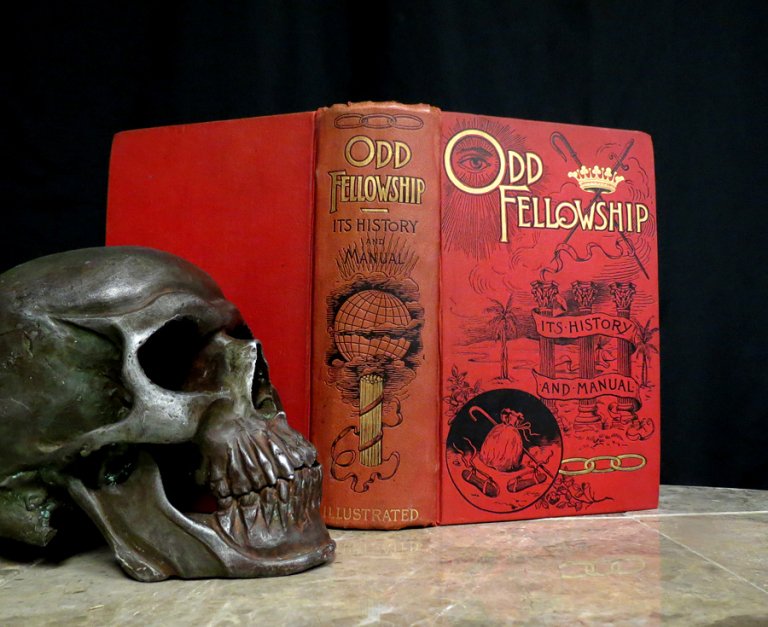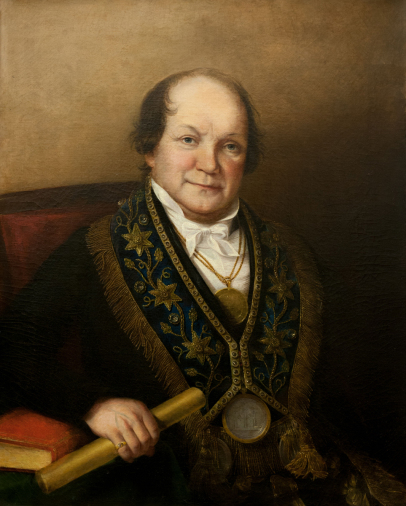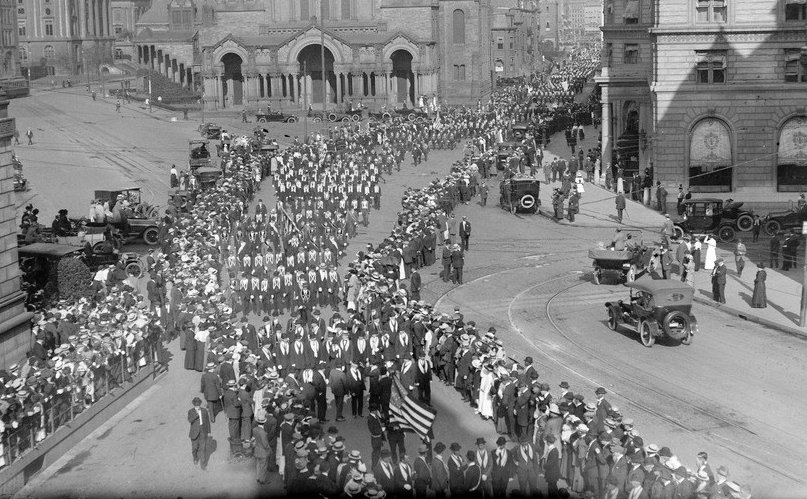History of America Oddfellowship

Rise of the American Order
The first lodge established on this continent was Shakespere, No. 1, New York city, 26 Dec. 1806. The five Odd Fellows composing this lodge were of the Loyal Independent Order and the moving spirits were Solomon Chambers and his son John C., English mechanics from the south of London.
The founders were three boat builders, a comedian, and a vocalist – a group befitting the name “Odd Fellows,” indeed. The lodge was self-instituted, a common practice in those times. Their first candidate was a retired actor who was the keeper of the tavern where they met. Accounts state that lodge meetings were accompanied by merry making and mirth and that the wares of the tavern were freely indulged in.
The early members were zealous workers and other lodges were soon organized. In 1809 the roll of membership, in the six New York City lodges, comprised 36 prominent citizens and business men, as well as many others of less influence. Shakespeare Lodge was dissolved in 1813 due to poor attendance brought on by controversy over the War of 1812. The other lodges of which little is known existed briefly until 1816. In 1818, Shakespeare Lodge in New York was re-instituted in the Red Cow tavern, operated by a former member who had in his keeping the books and papers of the former lodge.

Enter Thomas Wildey
Washington Lodge, No. 1, of Baltimore, was organized 26 April 1819 under the leadership of Thomas Wildey, now recognized as the founder of American Odd Fellowship.
Thomas Wildey was born in London, England, January 15, 1782. He was left an orphan five years later – and the Odd Fellow pledge to “Educate the Orphan” sprang from his personal childhood experiences. At the age of 14, Wildey went to live with an uncle. After he had 9 years of schooling, he became an apprentice to a maker of coach springs. He was initiated into the Odd Fellows in 1804 on reaching manhood (age of 21) in which he distinguished himself by his zeal and integrity and quickly “passed the chairs”.
When restlessness brought Thomas Wildey to America in 1817, the British were still unpopular in the States because of the War of 1812. In that year Baltimore was suffering both a yellow fever epidemic and mass unemployment. An outgoing personality, Wildey missed companionship and was determined to find if there were any other Odd Fellows in Baltimore.
A second lodge was formed in Baltimore in 1819, but these two lodges and those in New York were unaware of each others’ existence for some time, communications being slow in those days, and there being no reason such information would travel from one city to another except by pure chance.
On 26 Dec. 1821 Pennsylvania Lodge, No. 1, Philadelphia, was formed, like those in New York, Boston and Baltimore, on the self-institution principle, John Pearce being the leader and his associates were, likewise, English mechanics. While the Order had been planted in four States and the chief cities thereof according to ancient usage, an effort was soon made to frame constitutions and to obtain charters from the so-called regular bodies of Odd Fellows in England.
The consolidated Order became at once homogeneous and prosperous. As a prelude to these momentous events, coincident with the actual foundation of the American Order, the managers in Maryland had organized the Grand Lodge of Maryland and of the United States, 22 Feb. 1821, which relegated Washington N0. 1 and others, in Maryland, to the condition of subordinate lodges.
Following the centralization of the government of the four pioneer commonwealths, the “Grand Lodge of the United States” was evolved, on 15 Jan. 1825, by the representatives of the Grand Lodges of Massachusetts, New York, Pennsylvania and Maryland, the last-named taking her place with the State Grand bodies, subordinate to the sovereign head. This theory of a government composed of one head, the source and repository of all true Odd Fellowship, with subordinate State bodies and lodges subordinate, in contradistinction to the English system of a governing movable committee, was due to the genius of John Pawson Entwistle, who had joined the Order in 1820, becoming the brains of the young organization; Entwistle, the first Deputy Grand Master, was afterward Grand Secretary, but his career as a “builder” was cut short by his early decease.
The last link in the chain of regularity was forged 15 May 1826, when the American body was chartered by the Manchester Unity. Significant of this, the early charters were issued to the Order of Independent Odd Fellows and the branches originating in the United States were organized irrespective of the consent of the English body even prior to 1842-43, the date of official separation.
Facsimile of 1826 Charter establishing the Grand Lodge of America, in 1879 to become the Sovereign Grand Lodge of the IOOF
Thomas Wildey held the position of Grand Sire (Now referred to as Sovereign Grand Master) until 1833 when he retired from official station, though remaining an active working member of the Order, and a regular attendant at the sessions of the Grand Lodge of the United States.
With the official split from the Manchester Unity in 1843, the organization name was changed to Independent Order of Odd Fellows.
On September 20, 1851, IOOF became the first national fraternity to accept both men and women when it formed the Daughters of Rebekah. Schuyler Colfax(Vice President of the United States (1869–1873) under President Ulysses S. Grant) was the force behind the movement. This is a branch to which both sexes are admitted, but was made with a view to admitting women to the Order. Later the name was changed to Rebekahs.
In 1861, Thomas Wildey passed away. At the time of his death, there were more than 200,000 members of the IOOF. In April 1865 a monument was erected to Wildey in Baltimore, consisting of a statue on a Doric column that is 52 feet in height. The monument is located on North Broadway Street between East Baltimore and Fayette Streets.
Wildey Monument in Baltimore, MD
Thomas Wildey’s grave
The American Civil War (1861–1865) shattered the IOOF in America; membership decreased and many lodges were unable to continue their work, especially in the southern States. During these years, the roll of the Southern jurisdictions was regularly called during the annual sessions of the Sovereign Grand Lodge. At the close of the war, the officers and members in the South were welcomed to the chairs and seats which had been held for them during the four years of strife and separation. The roll-call at Baltimore, 18 Sept. 1865, by the venerable Grand Secretary Ridgely, was notable even in fraternal circles. Every survivor answered to his name and appointments had been made to fill vacancies so that the representation was complete. Attempts had been made throughout the States composing the Southern Confederacy, with varying success, to keep up the organizations of the Order; but, at this reunion, measures were unanimously adopted whereby fraternal hands and hearts assisted in rebuilding the waste places. This was the first fraternization of the Blue and the Gray. The procession in the streets of Baltimore the next day, occupying more than one hour in passing any given point, attracted national attention. The marshals were Joseph Kidder of New Hampshire and John Q. A. Herring of Maryland.

The Golden Age of Fraternalism
After the Civil War, with the beginning of industrialization, the deteriorating social circumstances brought large numbers of people to the IOOF and the lodges rallied.
Over the next half-century, also known as the “Golden age of fraternalism” in America,the Odd Fellows became the largest among all fraternal organizations, (at the time, even larger than Freemasonry). By 1889, the IOOF had lodges in every American state. In 1896, the World Almanac showed the Odd Fellows as the largest among all fraternal organizations.
By the late nineteenth century, the Order had spread to most of the rest of the world, establishing lodges in the Americas, Australasia, and Europe. According to the Journal of the Annual Communication of the Sovereign Grand Lodge 1922, page 426, there were a reported 2,676,582 members. While this data from 1921 may not be the exact zenith of its membership, the organization experienced a loss in membership of 23.5% between 1920-1930. This shift was due to the Great Depression and the introduction of Franklin D. Roosevelt‘s New Deal which knelled the end of the Golden age of fraternalism and started a decline in membership. During the Depression, people could not afford Odd Fellows membership fees and many lodges closed, and when the New Deal’s social reforms started to take effect, the need for the social work of the Odd Fellows declined. The Modern Era
In 1971 the IOOF changed its constitution, removing its whites only clause. In 1979 the Order had 243,000 members.
In 2001 the IOOF voted to allow women to join the Odd Fellows itself.
Although there was a decline in membership in fraternal organizations in general during the 20th century, membership in the 21st century started to increase with new generations discovering the charitable fraternal experience with the Order, being drawn to its “History and its Mystery”. Several jurisdictions are experiencing a net growth in membership and the Order has been recently reestablished the Grand Lodge of the Philippines.
April 26, 2019 Marks the 200th anniversary of the self institution of Washington Lodge No. 1 by Thomas Wildey.
Government and Degrees
Between 1826 and 1885 the government of the Order had been evolutionary in its nature. The inheritance from England in ritualistic matters was the merest outline of a possible utility. The degrees were crude in structure and unsuited to the genius of a modern fraternal society, being copies from orders of other origin — notably from Masonry. When the foundations of government had become settled, attention began to be paid to degrees of higher significance than the lodge system. Entwistle gave the first impulse to this part of the fabric of Odd Fellowship.
After his death the work was continued by a long line of distinguished Odd Fellows, including such American citizens as James L. Ridgely, Grand Secretary from 1838 to 1881; James B. Nicholson, Isaac McKendree Veitch, Schuyler Colfax, who may be said to have been the “builders” of the Order; Rev. Edwin H. Chapin, D.D., Rev. James D. McCabe, D.D., Tal. P. Shaffner, who, together with Entwistle and Ridgely, were largely the authors of the present American ritual. Two English degrees and one American, finally, made up the encampment series. As early as 1821-25 these were conferred in connection with the lodge department. The final separation of the encampments into a distinct branch, higher than the lodge and governed by Grand Encampments, did not occur until 1841.
In 1851-52 the Rebekah degree was adopted, its author being Schuyer Colfax.
The sequence of degrees was completed in 1885 by the adoption of the Patriarchs Militant and organization of the uniform or display branch. The Grand bodies followed the sequences of the degrees.
In 1879 the name of the supreme body was changed to the Sovereign Grand Lodge, a title more in consonance with its inherent powers, especially in its jurisdiction without the United States of America. The Sovereign Grand Lodge is made up of Grand Representatives from the Grand Lodges and Grand Encampments of the United States and Canada. Grand Lodges possess jurisdiction over State and Provincial Rebekah Assemblies and Rebekah lodges, as well as in the government of subordinate lodges. The Patriarchs Militant, with the local unit, called Canton, is organized like the United States Army, with Department Councils, all under the immediate government of the Sovereign Grand Lodge.
In Australasia, Denmark, Germany, the Netherlands, Sweden and Switzerland, Quasi-Independent Grand Lodges govern the Order. These hold an allegiance to the Sovereign Grand Lodge, use the American ritual modified, and a common bond exists in connection therewith; but they do not enjoy a representation in the sovereign head. They, however, govern the Order in the countries named and conform to the laws and usages of the civil governments thereof. The development of this dual system was the labor of many years and varied experiments.
Other Organizations of Odd Fellows
The largest body is the Manchester Unity Manchester Unity, numbering 950,000 members. It has lodges throughout Great Britain and its colonies — a few in the United States — and is, in effect, a chartered benefit society. Annual reports are made to the government, under the laws regulating Friendly societies and actuaries determine the solvency or insolvency of the Order and license lodges accordingly. In ritual matters, likewise, it has nothing in common with American Odd Fellowship. The English Grand United Order ranks next in relative importance and is the parent body of the Grand United Order of Odd Fellows in the Americas, Caribbean, and Africa for members of color founded in 1843 by Peter Ogden. Other Friendly societies exist in Great Britain and are of more or less importance as health insurance associations.


